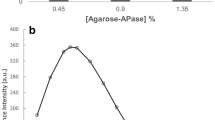Abstract
Rabbit muscle pyruvate kinase was immobilized by covalent attachment to a polyacrylamide support (Akrilex C) containing carboxylic functional groups. As a result of immobilization, the pH optimum for catalytic activity shifted into a more alkaline direction. The apparentK m value with phosphoenolpyruvate increased, and that with ADP slightly decreased. With respect to the stability against urea and thermal inactivation, the immobilized pyruvate kinase seemed to be the more stable at lower urea concentrations and between 45 and 55°C. At 1.5 and 2.5M urea and at higher temperature, there were no marked differences between the soluble and the immobilized enzyme.
Similar content being viewed by others
References
Silman, I. M., and Katchalski, E. (1966),Annu. Rev. Biochem. 35, 873.
Mosbach, K. (1976), Immobilized Enzymes, inMethods in Enzymology, Vol.44, S.P. Colowick and N. O. Kaplan, eds., Academic Press, New York.
Wilson, R. J. H., Kay, G., and Lilly, D. (1968),Biochem. J. 109, 137.
Campbell, J., and Chang, T M. S. (1975),Biochem. Biophys. Acta 397, 101.
Newirth, T. L., Diegelman, M. A., Pye, E. K., and Kallen, R. G. (1973),Biotechnol Bioeng. 15, 1089.
Kay, G., Lilly, M. D., Sharp, A. K., and Wilson, R. J. H. (1968),Nature 217, 641.
Beisenherz, G., Boltze, H. J., Bücher, T., Czök, R., Garbade, K. H., MeyerArendt, E., and Pfeiderer, G. (1953), Z.Naturforsch. 8, 555.
Kremmer, T., and Boross, L. (1979)Gel Chromatography: Theory, Methodology, Applications, Academia Kiado, Budapest.
Lowry, O. H., Rosebrough, N. J., Farr, A. L., and Randall, R. J. (1951),J. Biol. Chem. 193, 65.
Pon, N. G., and Bondar, R. J. L. (1967),Anal. Biochem. 19, 272.
Goldstein, L., Levin, Y., and Katchalski, E. (1964),Biochemistry,3, 1913.
Kovács, K., Szajáni, B., and Boross, L. (1982),J. Appl. Biochem. 4, 11.
Steinmetz, M. A., and Deal, W. C., (1966),Biochemistry 5, 1399.
Cottam, G. L., Hollenberg, P. F., and Coon, M. J. (1969),J. Biol. Chem. 244, 1481.
Johnson, G. S., Kayne, M. S., and Deal, W. C.(1969),Biochemistry 8, 2455.
Doster, W., and Hess, B. (1981),Biochemistry 20, 772.
Price, N. C., and Stevens, E. (1983),Biochem. J. 209, 763.
Author information
Authors and Affiliations
Rights and permissions
About this article
Cite this article
Simon, L.M., Kotormán, M., Szajáni, B. et al. Comparative studies on soluble and immobilized rabbit muscle pyruvate kinase. Appl Biochem Biotechnol 11, 195–205 (1985). https://doi.org/10.1007/BF02798476
Received:
Accepted:
Issue Date:
DOI: https://doi.org/10.1007/BF02798476



